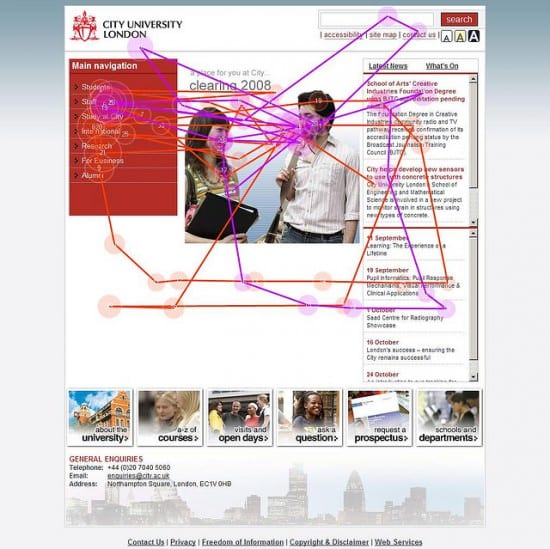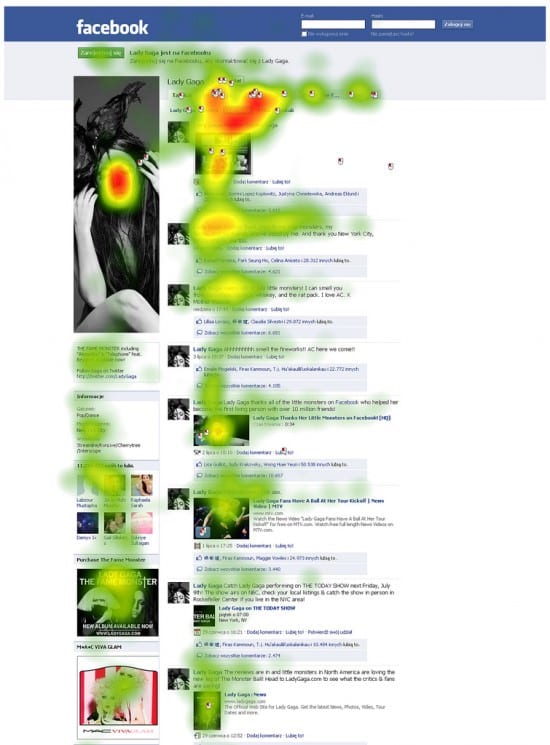When businesses use eye tracking data to help them design their website they could be missing vital information about their web visitors
Eye tracking studies are undoubtedly useful. Let’s get that fact out-of-the-way first. These specialist studies show exactly where people look on web pages and as a result web designers can ensure that specific elements are positioned for maximum visibility. But are these studies as valuable as they might seem? In this article I shall explain why eye tracking studies have limitations which companies should consider when they are building their websites. What you’ll discover in this article is:
- How eye tracking works
- What eye tracking tells you
- What eye tracking does not tell you
- The major flaw with eye tracking
- Filling in the gaps of eye tracking
- The place of eye tracking in marketing
How eye tracking works
Eye tracking can be performed in various ways, but generally small cameras track the movement of the pupils as people access a web page. Studies usually involve a group of volunteers who are asked to look at a set of web pages, often in the design or pre-launch stage.
The idea is that by looking at how people move their eyes around a web page, designers can change the layout to create greater engagement on the things that matter to the owner of the web page.
Eye tracking studies use specialist monitors which have several small cameras around the edge that together can provide an accurate position of the direction in which the pupils are looking. The cameras also produce data which shows how long a particular area on the screen was focused on. This leads to the production of a chart showing where the pupils were fixed and where they were moving. This chart is overlayed on the web page itself to produce what is known as a “gaze plot”, which shows where the pupils were fixed on a particular point and where they were moving. Typically, a gaze plot shows that people focus on a wide variety of points on a page, moving their eyes quickly and somewhat randomly around the page. The gaze plot below from City University, London, shows how eyes move around - notice that several parts of the page never get looked at.

A “gaze plot” of a web page showing what people looked at, Courtesy: City University
What eye tracking tells you
Gaze plots can potentially tell you which parts of your web pages are most attractive to people. The gaze plots show exactly where people look, so something in those positions has really “caught their eye”. The plots also show the directions the visitors’ eyes travelled, showing the way they move around the page. The gaze plots also tell you how long someone stays focused on each point on the web page.
Several gaze plots from several people can be combined and software can then produce what is known as a “heat map”. This shows the most interesting parts of a web page based on the average time and the number of people who look at each particular part. The most popular areas are coloured red, with orange, yellow and green showing decreasingly viewed areas.
It is important to note, however, that the heatmaps and gaze plots only show you what the pupils of the visitors were directed at and for how long; eye tracking studies do not tell you what people actually saw.
What eye tracking does not tell you
Eye tracking is rather raw data. It only shows the direction of the pupils and how long the pupils stayed still. However, as you know whilst you are reading this page, your pupils may well be fixed on the screen, but you can still see several things around you in the room, thanks to the wide angle of peripheral vision that we have.
It means that even though people may be fixing their gaze on a particular point on a web page, they may be seeing something else.
Heatmaps of Google search results pages, for instance, show that almost no-one ever looks at the sponsored links on the right hand side of the page. Yet, in spite of almost no-one apparently seeing these advertisements, clicks on them generated nearly $60bn for Google in the past year. Not bad out of a portion of a page which “doesn’t get viewed” according to eye-tracking studies.
Meanwhile, in almost every undergraduate psychology course around, students will conduct a standard memory test which asks people to look at a picture. The participants in the test are also told they will be asked questions about specific items in the image. This is to make sure they focus on a particular region. Then, after the picture is taken away they are given a quiz which asks them questions about the elements of the image they focused on. But they are also asked questions about portions of the image which they were not focusing on. Yet in spite of this, their recall of portions of the image they did not look at is still very good. Other psychological tests confirm that we can recall many things we are not actually looking at.
Eye tracking studies tell us what website visitors are looking at; they do not show us what people see.
The major flaw with eye tracking
Eye tracking equipment onlyreally measures the direction of the gaze and fixations of the eye. Yet we do not see with our eyes. Our eyes merely turn light into electrical signals that can be interpreted by the brain. We see with our brain.
Eye tracking studies, whilst showing us useful information as to how people travel around a web page and how long they spend looking at things, does not tell us what people see. And yet that is the really useful information we want to know.
After all, when someone spends a long time looking at a particular point on a web page is it because they are interested, or is it because they are confused? When they move from each element on a web page, is this because those things attract the visitor’s attention, or is it because the visitors have yet to find anything that interests them and hop from item to item in a bid to find something worthwhile?
The biggest problem with eye tracking is that it doesn’t tell us what is happening in a visitor’s brain.
As a result web designers can gain false information. They can, for instance, use eye tracking which confirms that people see the relevant calls to action on a page. The design team goes away happy that their design works. But what if the eye tracking were merely showing that people spent a long time on these calls to action because they didn’t make sense and they were struggling to read them? Eye tracking data can make things on a web page appear positive to designers, when in reality they may be negative. Time spent looking at an item on a web page can signal interest and appeal, but it can also be due to confusion and lack of clarity.
Filling in the gaps of eye tracking
Having suggested that eye tracking has a significant flaw, it doesn’t mean it cannot be used. Indeed, it is an excellent tool in deciding where to place marketing elements within a web page. But the gap in terms of knowing why a person looked at a point on a page for more than a few seconds is understanding why.
- Eye tracking alone has limited value.
This means combining eye tracking with psychological studies is ideal. Testing people after they have visited a web page to find out what they saw in their peripheral vision can bring benefits, for instance. Interviews with people to elicit their motivation for their direction of travel around the page can also add to the data from eye tracking studies. You need more information from psychological testing to supplement the eye tracking data if you want to interpret heatmaps or gaze plots accurately.
The place of eye tracking in marketing
Eye tracking is a useful procedure, but it is only part of your marketing testing kit, just one tool in your box. Most eye tracking studies, though, are done for usability, yet these techniques do have value in marketing.
- They help you find out how best to move people around the page so they go where you want them to go
- They can help you discover which calls to action are working best
- They can assist you in creating more conversions as a result of placing key parts of your marketing in the most viewed positions on a page
But they are only part of the process. If you want to use eye tracking studies alone, you will only get limited information which may give you a false impression of what is really happening. You need to combine eye tracking data with psychological testing too.








